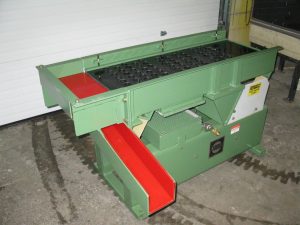 Six tips for simpler screen separation
Six tips for simpler screen separation
August 28, 2015 REDWIRE is news you can use from leading suppliers. Powered by FRASERS.
Posted by Vibra Finish Limited
Vibra Finish Limited is a manufacturer of vibratory finishing, centrifugal finishing, tumbling, separating, vibro-peenin... Read more
Subscribe
Free REDWIRE e-newsletter

After the injection moulding process is complete, unwanted material must be removed from the casting. This typically involves tumbling the dies in an open mouth barrel and then screen separating the parts. The separation process, however, is often time-consuming. But it doesn’t have to be, according to Vibra Finish.
A recent blog on the company’s website offers tips and solutions on how to decrease the time spent moving and screening the parts.
- Alter the barrel. A standard horizontal enclosed barrel tumbler can be altered by adding an extra large door opening. The load is then tumble-degated, which removes flash and polishes. The solid door can then be removed and replaced by a screen door. As the barrel rotates, the parts fall out, leaving all the gates in the barrel. This method allows the parts to be degated, deflashed and separated at one station, without having to physically move any parts.
- Use an oblique tilting tumbler. While horizontal barrels are faster and more thorough when it comes to screen separation, there may be applications where a tilt tumbler is already in place. To avoid the cost of another tumbler, there is a solution. The principle described above can also be applied to the oblique (tilt) tumbler. As the blog describes it: “Locks can be added to the mouth of the barrel to clamp on a screen door. The barrel is loaded [and] then the screen door is put in place. The barrel is run at a 45-degree upward tilt until the pieces are broken off and smoothed out. The barrel is then tilted down 45 degrees, bringing the load forward to the screen.”
- Increase speed. Generally, barrel tumblers run at a high surface feet per minute. Do not add more fins for more aggressive action because this can damage the surface of the parts. It is better to increase the speed to get a shorter run.
- Minimize the thickness. When planning moulds, always minimize the thickness of the sprue at the point of junction. The best configuration is a smooth radius or taper rather than a notch or step.
- Use rollers. Various machines are built specifically for the separation operation. A set of rollers at a slight angle to each other, rotating counter to each other, spin parts to allow them to fall through the gap. The gap widens as they move down, and each part falls through at the appropriate point. This type of system is very good for small parts, but not for a large number of parts at once.
- Use a drop-off screen. Large parts can be handled in any volume using a drop-off screen — vibrating screens that feed the load to the far end, dropping the scrap through the screen. The parts drop off the end into catch pans.
Vibra Finish adds one important tip: It is simpler to plan media selection for ease of separation at the start of the project, rather than trying to design an elaborate separation system at the end of the project.
Contact Vibra Finish for more screen separation tips, or to learn about its Vibra Degater, a system that separates castings from runners without the need for trim dies or presses. It is custom designed to meet the customer's specific needs, reducing tooling and labour costs, while increasing productivity.
Share
Posted by Vibra Finish Limited
Vibra Finish Limited is a manufacturer of vibratory finishing, centrifugal finishing, tumbling, separating, vibro-peenin... Read more